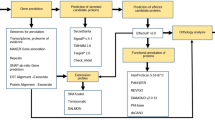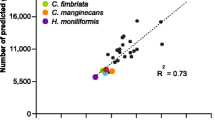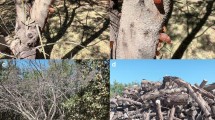Abstract
Natural variants of cerato-platanin (CP), a pathogen associated molecular pattern (PAMP) protein produced by Ceratocystis platani (the causal agent of the plane canker stain), have been found to be produced by other four species of the genus Ceratocystis, including five clones of Ceratocystis fimbriata isolated from different hosts. All these fungal strains were known to be pathogenic to plants with considerable importance in agriculture, forestry, and as ornamental plants. The putative premature proteins were deduced on the basis of the nucleotide sequence of genes orthologous to the cp gene of C. platani; the deduced premature proteins of Ceratocystis populicola and Ceratocystis variospora reduced the total identity of all the others from 87.3% to 60.3%. Cerato-populin (Pop1), the CP-orthologous protein produced by C. populicola, was purified and characterized. Pop1 was a well-structured α/β protein with a different percentage of the α-helix than CP, and it self-assembled in vitro in ordered aggregates. Moreover, Pop1 behaved as PAMP, since it stimulated poplar leaf tissues to activate defence responses able to reduce consistently the C. populicola growth.




Similar content being viewed by others
References
Anderson M, Bocharova OV, Makarava N, Breydo L, Salnikov VV, Baskakov IV (2006) Polymorphism and ultrastructural organization of prion protein amyloid fibrils: an insight from high resolution atomic force microscopy. J Mol Biol 358:580–596
Baker CJ, Harrington TC, Krauss U, Alfenas AC (2003) Genetic variability and host specialization in the Latin American clade of Ceratocystis fimbriata. Phytopatology 93:1274–1284
Barnes I, Gaur A, Burgess T, Roux J, Wingfield BD, Wingfield MJ (2001) Microsatellite markers reflect similar relationship between isolates of the vascular wilt and canker pathogen Ceratocystis fimbriata. Mol Plant Path 2:319–325
Bennici A, Calamassi R, Pazzagli L, Comparini C, Schiff S, Bovelli R, Mori B, Tani C, Scala A (2005) Cytological and ultrastructural responses of Platanus acerifolia (Ait.) Willd. leaves to cerato-platanin, a protein from Ceratocystis fimbriata f. sp. platani. Phytopathol Mediterr 44:153–161
Benson JR, Hare PE (1975) o-Phthalaldehyde: fluorogenic detection of primary amines in the picomole range. Comparison with fluorescamine and ninhydrin. Proc Natl Acad Sci USA 72:619–622
Bent AF, Mackey D (2007) Elicitors, effectors, and R genes: the new paradigm and a lifetime supply of questions. Annu Rev Phytopathol 45:399–436
Boddi S, Comparini C, Calamassi R, Pazzagli L, Cappugi G, Scala A (2004) Cerato-platanin protein is located in the cell walls of ascospores, conidia and hyphae of Ceratocystis fimbriata f. sp. platani. FEMS Microbiol Lett 233:341–346
Carresi L, Pantera B, Zoppi C, Cappugi G, Oliveira AL, Pertinhez TA, Spisni A, Scala A, Pazzagli (2006) Cerato-platanin, a phytotoxic protein from Ceratocystis fimbriata: expression in Pichia pastoris, purification and characterization. Protein Expr Purif 49:159–167
Chisholm ST, Coaker G, Day B, Staskawicz BJ (2006) Host-microbe interactions: shaping the evolution of the plant immune response. Cell 124:803–814
Chiti F, Dobson CM (2006) Protein misfolding, functional amyloid, and human disease. Annu Rev Biochem 75:333–366
Djonovic S, Pozo MJ, Dangott LJ, Howell CR, Kenerley CM (2006) Sm1, a proteinaceous elicitor secreted by the biocontrol fungus Trichoderma virens induces plant defense responses and systemic resistance. Mol Plant Microbe Interact 19:838–853
Djonovic S, Vargas WA, Kolomiets MV, Horndeski M, Wiest A, Kenerley CM (2007) A proteinaceous elicitor Sm1 from the beneficial fungus Trichoderma virens is required for induced systemic resistance in maize. Plant Physiol 145:875–889
Engelbrecht CJB, Harrington TA (2005) Intersterility, morphology and taxonomy of Ceratocystis fimbriata on sweet potato, cacao and sycamore. Mycologia 97:57–69
Engelbrecht CJB, Harrington TC, Steimel J, Capretti P (2004) Genetic variation in eastern North American and putatively introduced populations of Ceratocystis fimbriata f. platani. Mol Ecol 13:2995–3005
Finn RD, Tate J, Mistry J, Coggill PC, Sammut JS, Hotz HR, Ceric G, Forslund K, Eddy SR, Sonnhammer EL, Bateman A (2008) The Pfam protein families database. Nucleic Acids Research, Database Issue 36:D281–D288
Flor HH (1971) Current status of the gene-for-gene concept. Annu Rev Phytopathol 9:275–296
Fontana F, Santini A, Salvini M, Pazzagli L, Cappugi G, Scala A, Durante M, Bernardi R (2008) Cerato-platanin treated plane leaves restrict Ceratocystis platani growth and overexpress defence-related genes. J Plant Pathol 90:295–306
Glazebrook J (2005) Contrasting mechanisms of defense against biotrophic and necrotrophic pathogens. Annu Rev Phytopathol 43:205–227
Gressel J, Meir S, Herschkovitz Y, Al-Ahmad H, Greenspoon I, Olubukola B, Amsellem Z (2007) Approaches to and successes in developing transgenically enhanced mycoherbicides. In: Vurro M, Gressel J (eds) Novel biotechnologies for biocontrol agent enhancement and management. Springer Netherlands, Amsterdam, pp 297–305
Hamberger B, Ellis M, Friedmann M, de Azevedo Souza C, Barbazuk B, Douglas CJ (2007) Genome-wide analyses of phenylpropanoid-related genes in Populus trichocarpa, Arabidopsis thaliana, and Oryza sativa: the Populus lignin toolbox and conservation and diversification of angiosperm gene families. Can J Bot 85:1182–1201
Jeong JS, Mitchell TK, Dean RA (2007) The Magnaporthe grisea snodprot1 homolog, MSP1, is required for virulence. FEMS Microbiol Lett 273:157–165
Johnson JA, Harrington TC, Engelbrecht C (2005) Phylogeny and taxonomy of the North American clade of the Ceratocystis fimbriata complex. Mycologia 97:1067–1092
Krebs MR, MacPhee CE, Miller AF, Dunlop IE, Dobson CM, Donald AM (2004) The formation of spherulites by amyloid fibrils of bovine insulin. Proc Natl Acad Sci USA 101:14420–14424
Kulkarni RD, Kelkar HS, Dean RA (2003) An eight-cysteine-containing CFEM domain unique to a group of fungal membrane proteins. Trends Biochem Sci 28:118–121
Kurup VP, Banerjee B, Hemmann S, Greenberger PA, Blaser K, Crameri R (2000) Selected recombinant Aspergillus fumigatus allergens bind specifically to IgE in ABPA. Clin Exp Allergy 30:988–993
Kwan AH, Winefield RD, Sunde M, Matthews JM, Haverkamp RG, Templeton MD, Mackay JP (2006) Structural basis for rodlet assembly in fungal hydrophobins. Proc Natl Acad Sci USA 103:3621–3626
Kyte J, Doolittle RF (1982) A simple method for displaying the hydropathic character of a protein. J Mol Biol 157:105–132
Laemnli UK (1970) Cleavage of structural proteins during the assembly of the head of bacteriophage T4. Nature 227:680–685
LeVine H (1999) Quantification of the β-sheet amyloid fibril structures with Thioflavin T. Method Enzymol 309:274–284
Mao FL, Su ZC, Olman V, Dam P, Liu ZJ, Xu YN (2006) Mapping of orthologous genes in the context of biological pathways: an application of integer programming. Proc Natl Acad Sci USA 103:129–134
Marcos JF, Mũnoz A, Pérez-Payá E, Misra S, Lopez-García B (2008) Identification and rational design of novel antimicrobial peptides for plant protection. Annu Rev Phytopathol 46:273–301
Ocasio-Morales RG, Tsopelas P, Harrington TA (2007) Origin of Ceratocystis platani on native Platanus orientalis in Greece and its impact on natural forests. Plant Dis 91:901–904
Oliveira AL, Pazzagli L, Pantera B, Cappugi G, Benedetti CE, Spisni A, Pertinhez TA (2006) 1H, 15N and 13C resonance assignments of cerato-platanin, a phytotoxic protein from Ceratocystis fimbriata. J Biomol NMR 36:50
Oliveira AL, Pazzagli L, Cappugi G, Scala A, Gallo M, Cicero DO, Pantera B, Spisni A, Benedetti CE, Pertinhez TA (2009) The solution structure of cerato-platanin reveals a new fold among the protein fungal elicitors. ChemBioChem, submitted
Pan S, Cole GT (1995) Molecular and biochemical characterization of a Coccidoides immitis-specific antigen. Infect Immun 63:3994–4002
Panconesi A (1999) Canker stain of plane trees: a serious danger to urban plantings in Europe. J Plant Pathol 81:3–15
Pazzagli L, Cappugi G, Manao G, Camici G, Santini A, Scala A (1999) Purification of cerato-platanin, a new phytotoxic protein from Ceratocystis fimbriata f. sp. platani. J Biol Chem 274:24959–24964
Pazzagli L, Pantera B, Carresi L, Zoppi C, Pertinhez TA, Spisni A, Tegli S, Scala A, Cappugi G (2006) Cerato-platanin, the first member of a new fungal protein family: cloning, expression and characterization. Cell Biochem Biophys 44:512–521
Pontis RE (1951) A canker disease of the coffee tree in Colombia and Venezuela. Phytopathology 41:178–184
Santini A, Capretti P (2000) Analysis of the Italian population of Ceratocystis fimbriata f. sp. platani using RAPD and minisatellite markers. Plant Pathol 49:461–467
Sbrana F, Bongini L, Cappugi G, Fanelli D, Guarino A, Pazzagli L, Scala A, Vassalli M, Zoppi C, Tiribilli B (2007) Atomic force microscopy images suggest aggregation mechanism in cerato-platanin. Eur Biophys J Biophy 36:727–732
Scala A, Tegli S, Comparini C, Mittempergher L, Scala F, Del Sorbo G (1994) Influence of fungal inoculum on cerato-ulmin production, purification of cerato-ulmin and detection in elm sucker cuttings. Petria 4:53–63
Scala F, Bertelli E, Coppola L, Del Sorbo G, Tegli S, Scala A (1997) Comparative determination of cerato-ulmin on cell surface and in mycelial extracts of pathogenic and non-pathogenic Ophiostoma species. Mycol Res 101:829–834
Scala A, Pazzagli L, Comparini C, Santini A, Tegli S, Cappugi G (2004) Cerato-platanin, an early-produced protein by Ceratocystis fimbriata f. sp. platani, elicits phytoalexin synthesis in host and non-host plants. J Plant Pathol 86:23–29
Seidl V, Marchetti M, Schandl R, Allmaier G, Kubicek CP (2006) Epl1, the major secreted protein of Hypocrea atroviridis on glucose, is a member of a strongly conserved protein family comprising plant defense response elicitors. FEBS J 273:4346–4359
Sharen AL, Krupinski G (1970) Cultural and inoculation studies of Septoria nodorum, cause of Glume Blotch of wheat. Phytopathology 60:1480–1485
Tamura K, Dudley J, Nei M, Kumar S (2007) MEGA4: molecular evolutionary genetics analysis (MEGA) software version 4.0. Mol Biol Evol 24:1596–1599
Templeton MD, Rikkerink EHA, Beever RE (1994) Small, cysteine-rich proteins and recognition in fungal–plant interactions. Mol Plant-Microbe Interact 7:320–325
Tuskan GA, DiFazio S, Jansson S et al (2006) The genome of black cottonwood, Populus trichocarpa (Torr. & Gray). Science 313:1596–1604
Van Wyk M, Al Adawi AO, Khan IA, Deadman ML, Al Jahwari AA, Wingfield BD, Ploetz R, Wingfield MJ (2007) Ceratocystis manginecans sp. nov., causal agent of a destructive mango wilt disease in Oman and Pakistan. Fungal Divers 27:213–230
Vargas WA, Djonovic S, Sukno SA, Kenerley CM (2008) Dimerization controls the activity of Fungal elicitors that trigger systemic resistance in plants. J Biol Chem 283:19804–19815
Walsh DM, Hartley DM, Kusumoto Y, Fezoui Y, Condron MM, Lomakin A, Benedek GB, Selkoe DJ, Teplow DB (1999) Amyloid β-protein fibrillogenesis. Structure and biological activity of protofibrillar intermediates. J Biol Chem 274:25945–25952
White TJ, Bruns T, Lee S, Taylor J (1990) Amplification and direct sequencing of fungal ribosomal RNA genes for phylogenetics. In: Innis MA, Gelfand DH, Sninsky JJ, White TJ (eds) PCR Protocols: a guide to methods and applications. Academic, London, pp 315–322
Whiteford JR, Spanu PD (2002) Hydrophobins and the interactions between fungi and plants. Mol Plant Pathol 3:391–400
Wilson LM, Idnurm A, Howlett BJ (2002) Characterization of a gene (sp1) encoding a secreted protein from Leptosphaeria maculans, the blackleg pathogen of Brassica napus. Mol Plant Pathol 3:487–493
Witthuhn RC, Wingfield BD, Wingfield MJ, Wolfaardt M, Harrington TC (1998) Monophyly of the conifer species in the Ceratocystis coerulescens complex based on DNA sequence data. Mycologia 90:96–101
Wösten HAB (2001) Hydrophobins: multipurpose proteins. Annu Rev Microbiol 55:625–646
Yang X, Kalluri UC, Jawdy S, Gunter LE, Yin T, Tschaplinski TJ, Weston DJ, Ranjan P, Tuskan GA (2008) The F-box gene family is expanded in herbaceous annual plants relative to woody perennial plants. Plant Physiol 148:1189–1200
Zaparoli G, Cabrera OG, Medrano FJ, Tiburcio R, Lacerda G, Guimarães Pereira G (2009) Identification of a second family of genes in Moniliophthora perniciosa, the causal agent of witches broom disease in cacao, encoding necrosis-inducing proteins similar to cerato-platanins. Mycol Res 113:61–72
Acknowledgements
The work was supported by the Ministero Italiano dell’Università e della Ricerca Scientifica, Progetti di Ricerca di Interesse Nazionale 2005 and 2007 to A. Scala, G. Cappugi, and A. Santini.
Author information
Authors and Affiliations
Corresponding author
Electronic supplementary material
Below is the link to the electronic supplementary material.
Rights and permissions
About this article
Cite this article
Comparini, C., Carresi, L., Pagni, E. et al. New proteins orthologous to cerato-platanin in various Ceratocystis species and the purification and characterization of cerato-populin from Ceratocystis populicola . Appl Microbiol Biotechnol 84, 309–322 (2009). https://doi.org/10.1007/s00253-009-1998-4
Received:
Revised:
Accepted:
Published:
Issue Date:
DOI: https://doi.org/10.1007/s00253-009-1998-4




